
Home
Preamble
Index
Areas
Map
References
Me
Drakkar
Saunterings: Walking in North-West England
Saunterings is a set of reflections based upon walks around the counties of Cumbria, Lancashire and
North Yorkshire in North-West England
(as defined in the Preamble).
Here is a list of all Saunterings so far.
If you'd like to give a comment, correction or update (all are very welcome) or to
be notified by email when a new item is posted - please send an email to johnselfdrakkar@gmail.com.
151. From Cowan Bridge with the Brontës and Beyond
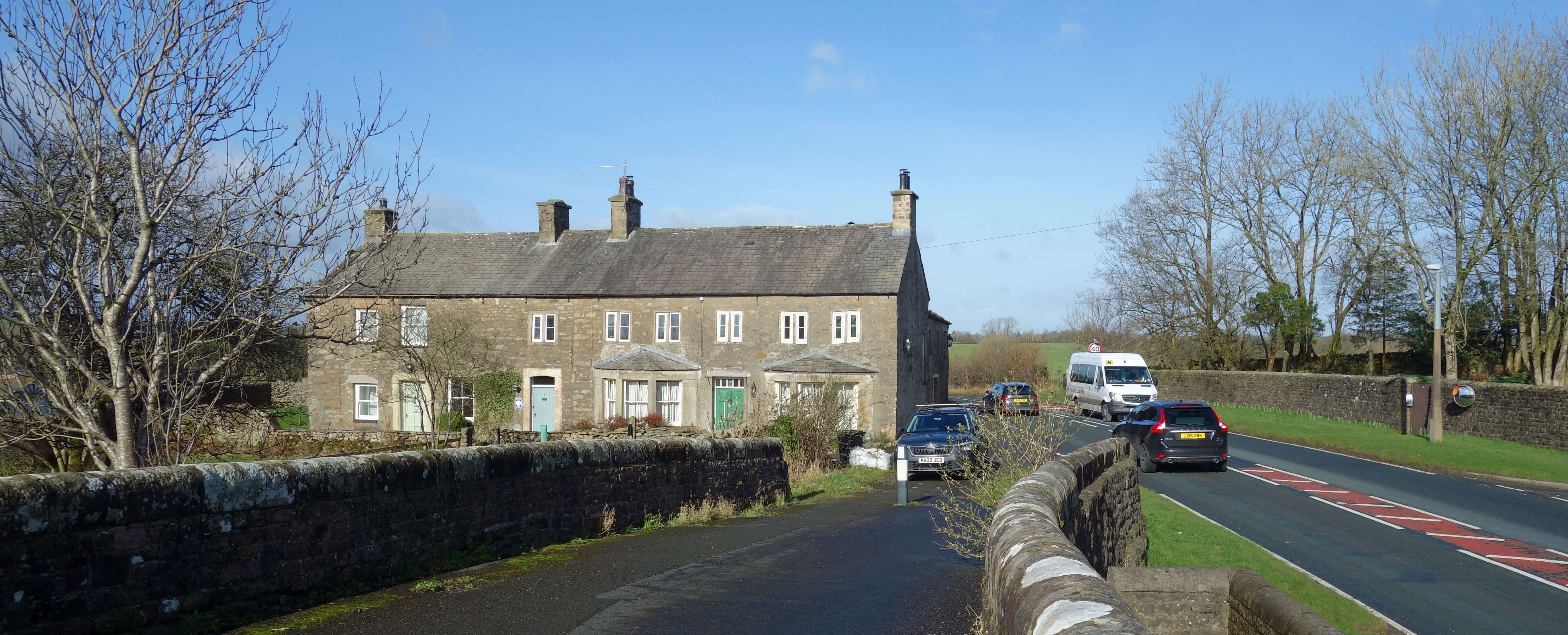
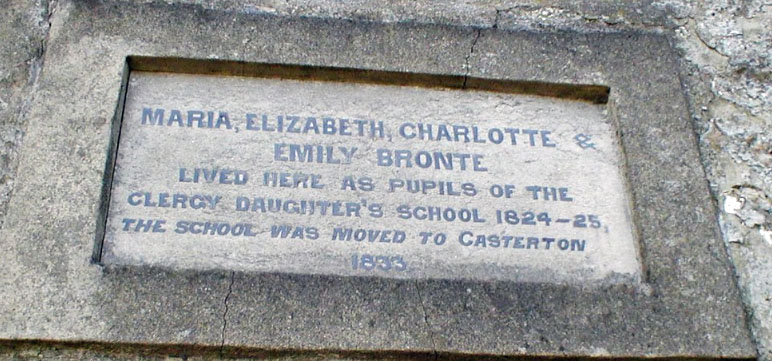
By the old bridge at Cowan Bridge on the wall of the terrace that was once a Clergy Daughters’
School (shown left) there’s a plaque (shown right). A pedant immediately spots two mistakes.
The apostrophe is in the wrong place and there’s no diaeresis (that is, two dots) over the ‘e’ of
Bronte. Regarding the latter, the Brontë sisters’ father, born Patrick Brunty, would have been
aghast that the plaque did not follow his masterful PR ploy to rename the family as Brontë. The
new name was designed to add panache that would later aid the sisters’ literary careers. However,
perhaps because printers of the day did not have an ë, the sisters (Charlotte, Emily and Anne)
at first called themselves
Currer, Ellis and Acton Bell when trying to get published – but perhaps more likely because they needed to pretend to be male.
As the plaque says, four of the Brontë sisters (Maria, Elizabeth, Charlotte and Emily) spent a year at the Clergy
Daughters’ School in Cowan Bridge in 1824-25. To say it was a miserable time would be an understatement.
The two oldest daughters (Maria and Elizabeth) became ill and died shortly after returning to Haworth.
They were not especially unlucky in that regard. Half of all deaths in the region at that time were of
children under ten, reducing average life expectancy to just 26 (Wellburn, 1997). The period was no doubt
traumatic for the surviving sisters. Charlotte drew upon the experience in
Jane Eyre, where
Lowood, Mr Brocklehurst, and Brocklebridge Church are analogues of the Clergy Daughters’ School, the Rev.
Carus Wilson (the headmaster) and Tunstall Church, to which the sisters walked on Sundays.
I followed their path. It led first to the hamlet of Overtown, which lies on the Ribchester to Carlisle Roman road. An inviting track is on the line of the Roman road but it is not a public footpath. Instead I spent a few minutes looking for the Roman milestone that is said to be at the corner of the modern road. If it’s the two-foot-high, moss-covered stone I found then I hope that some expert has good reason to declare it a Roman milestone.

Looking back to Overtown
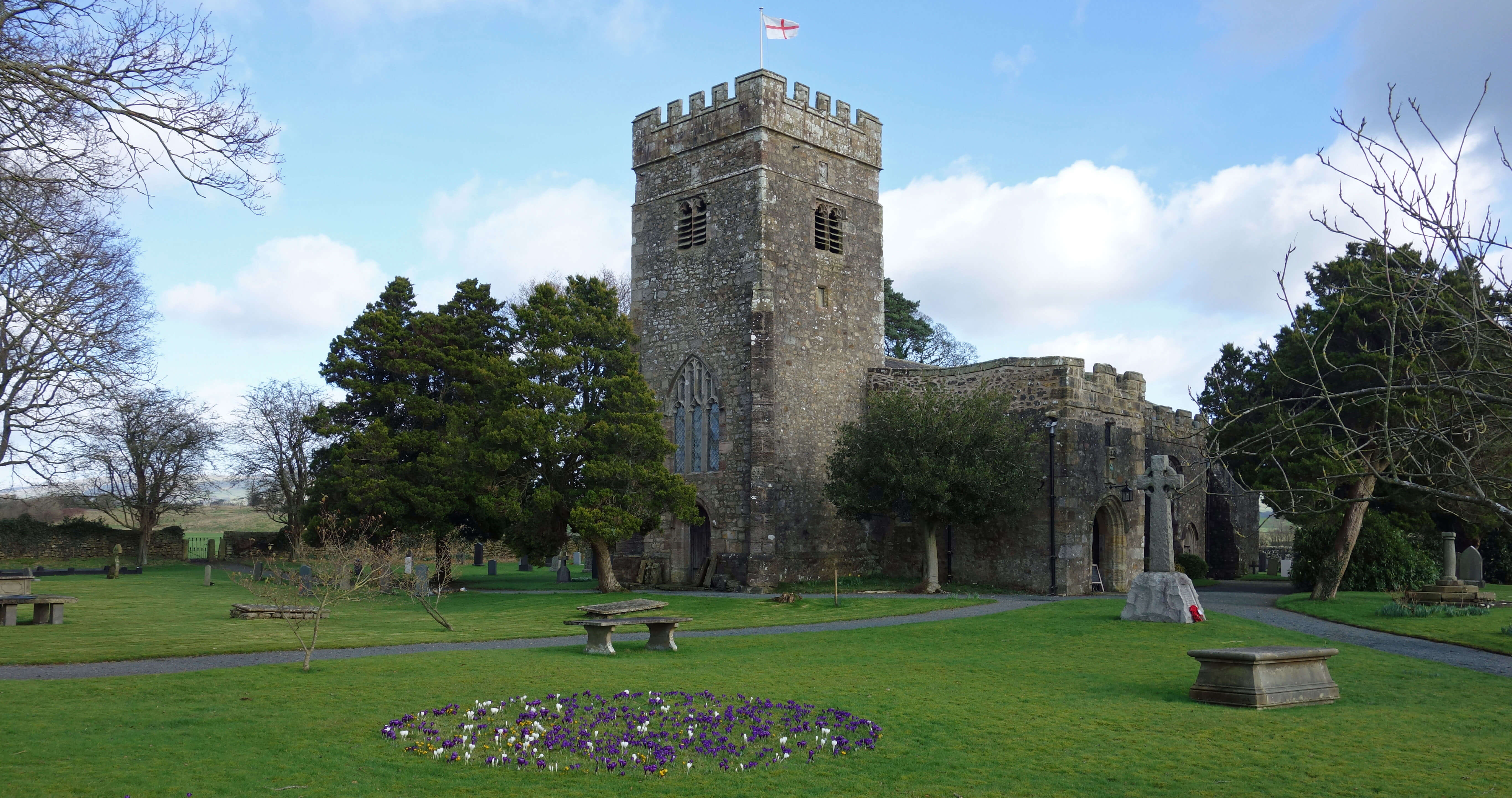 Right: Tunstall Church
Right: Tunstall Church
It is surprising what you come across hidden away on back roads. Further along Woodman Road I passed
several large sheds, a veritable industrial complex amongst the fields, with no sign saying what they
were for. They used to be for chickens – and probably still are but I could not see, hear or smell any sign of them.
If they are there, they’re certainly not free-range.
I now followed a track south past Churchfield House. The Charlotte Brontë description of this walk says “a bitter wind, blowing over a range of snowy summits to the north, almost flayed the skin from our faces”. That’s a fair description of the day of my walk. There was snow on the northern hills of Gragareth and Ingleborough, with a cold wind but at least some sunshine.
The track ended near
Tunstall Church,
which was the Brontës’ destination. According to
Jane Eyre, “we set out cold, we arrived at church colder: during the morning service we became almost paralysed”. While the 15th century church looks much as it did in the Brontës’ time, since it escaped the 19th century renovations that were carried out on most churches, it did not appear so bleak to me. I wandered inside and it seemed, like most churches, more spacious than expected.
Here I left the Brontës because they, of course, had to walk back to Cowan Bridge. I walked on
to the village of Tunstall and towards
Thurland Castle,
once the home of the illustrious Tunstall family.
I had always previously been driving past the castle, usually with the trees fully leaved, and I hoped
that this time I would be able to view it properly. But the castle was quite distant and still largely
hidden by trees. It is now strictly private and has, in any case, been converted into a dozen or so flats. I feel that an ex-castle
that is no longer fulfilling its castling duties should be stripped of its title.
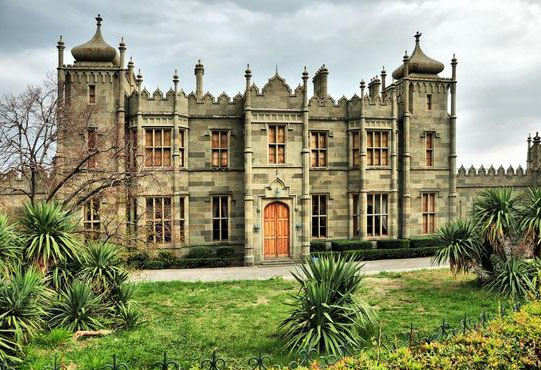
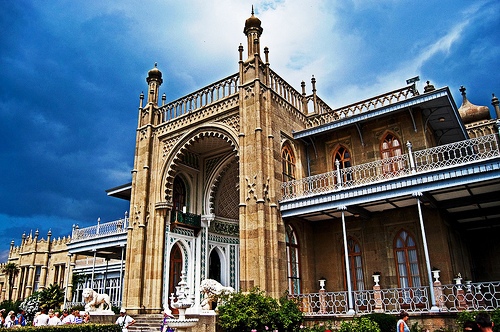
I carried on south on back roads, since the main roads were busy and the fields were waterlogged. It
was quiet and pleasant enough but my mind had wandered – as probably yours has too. I knew that it had been
predicted that while
I was out walking Russian forces would, on their second day in Ukraine, be entering its capital, Kyiv.
I reflected that in the 1990s I had been involved in an EU project involving partners from
Bulgaria, Romania and Ukraine. None of those countries were members of the EU at the time but the
political aim of the project was to demonstrate EU’s largesse (all three were relatively poor)
so that they would seek EU membership. The first two eventually did but not Ukraine.
Our Ukraine partners were from Simferopol in Crimea and they arranged for the project meeting
to be held in
Partenit,
on the Black Sea coast. We stayed at an old Soviet Union ‘military resort’ that reminded
me of the holiday camps of my childhood, except that it was surrounded by a security fence – to keep us in. I asked
to walk up the nearby Bear Mountain and I was allowed to do so but only under escort.
We were taken on an
appropriate outing to Yalta, where we saw the room in which in 1945 Churchill, Roosevelt and Stalin signed the
Declaration of Liberated Europe,
which did so much to cement the divided Europe that the EU was in the 1990s trying,
not so subtly, to unite. We also visited the nearby
Vorontsov Palace,
which is a most peculiar building.
It was built (1828-1848) in a mélange of architectural styles by
Edward Blore, who
is described by Wikipedia as an "English landscape and architectural artist, architect and antiquary",
although he had no formal training in architecture. He is better known for completing John Nash's
design for Buckingham Palace.
From the north Vorontsov Palace looks like an over elaborate British stately home (above left). From the south it is
the palace of an Indian maharajah (above right - these two are stock photos on-line, not my photos).
No doubt Blore was trying to capture the both-west-and-east nature
of the region. Now, of course, Partenit, Yalta and Vorontsov Palace are within Russian-occupied
territory – as much else will be soon, perhaps. I fervently hope not.
I was once partners with a few Ukrainians: I feel partners with all of them now.
I sat on the green at Wennington, waiting for the bus. A dipper zipped along the river
and three buzzards frolicked high above.
Date: February 25th 2022
Start: SD625765, Cowan Bridge (Map: OL2)
Route: (linear) SW, NW – Overtown – SW on Woodman Lane, S past Churchfield House – Tunstall Church – W – Tunstall – S past Thurland Castle, SE – Greta Bridge – SW, E – Wrayton, Bull Bank – S – Wennington
Distance: 6 miles; Ascent: 30 metres
Home
Preamble
Index
Areas
Map
References
Me
Drakkar
© John Self, Drakkar Press, 2018-

Top photo: The western Howgills from Dillicar;
Bottom photo: Blencathra from Great Mell Fell



 By the old bridge at Cowan Bridge on the wall of the terrace that was once a Clergy Daughters’
School (shown left) there’s a plaque (shown right). A pedant immediately spots two mistakes.
The apostrophe is in the wrong place and there’s no diaeresis (that is, two dots) over the ‘e’ of
Bronte. Regarding the latter, the Brontë sisters’ father, born Patrick Brunty, would have been
aghast that the plaque did not follow his masterful PR ploy to rename the family as Brontë. The
new name was designed to add panache that would later aid the sisters’ literary careers. However,
perhaps because printers of the day did not have an ë, the sisters (Charlotte, Emily and Anne)
at first called themselves
Currer, Ellis and Acton Bell when trying to get published – but perhaps more likely because they needed to pretend to be male.
By the old bridge at Cowan Bridge on the wall of the terrace that was once a Clergy Daughters’
School (shown left) there’s a plaque (shown right). A pedant immediately spots two mistakes.
The apostrophe is in the wrong place and there’s no diaeresis (that is, two dots) over the ‘e’ of
Bronte. Regarding the latter, the Brontë sisters’ father, born Patrick Brunty, would have been
aghast that the plaque did not follow his masterful PR ploy to rename the family as Brontë. The
new name was designed to add panache that would later aid the sisters’ literary careers. However,
perhaps because printers of the day did not have an ë, the sisters (Charlotte, Emily and Anne)
at first called themselves
Currer, Ellis and Acton Bell when trying to get published – but perhaps more likely because they needed to pretend to be male.

 Right: Tunstall Church
Right: Tunstall Church

 I carried on south on back roads, since the main roads were busy and the fields were waterlogged. It
was quiet and pleasant enough but my mind had wandered – as probably yours has too. I knew that it had been
predicted that while
I was out walking Russian forces would, on their second day in Ukraine, be entering its capital, Kyiv.
I carried on south on back roads, since the main roads were busy and the fields were waterlogged. It
was quiet and pleasant enough but my mind had wandered – as probably yours has too. I knew that it had been
predicted that while
I was out walking Russian forces would, on their second day in Ukraine, be entering its capital, Kyiv.
